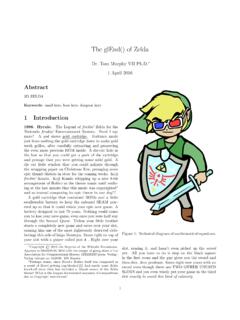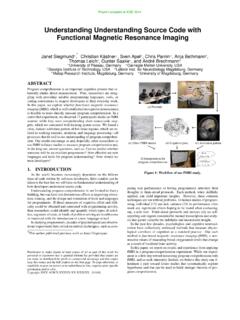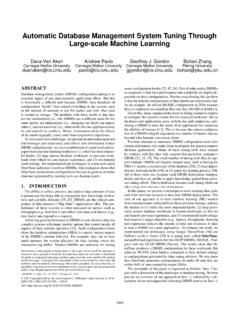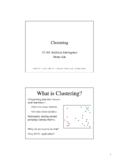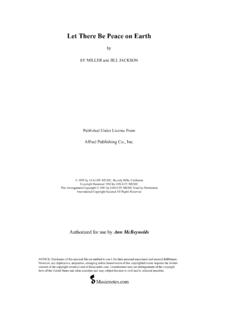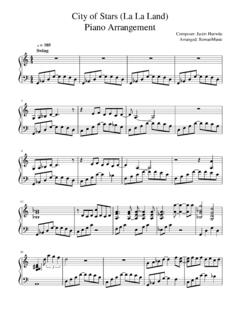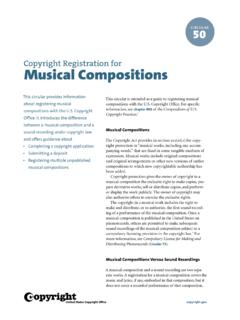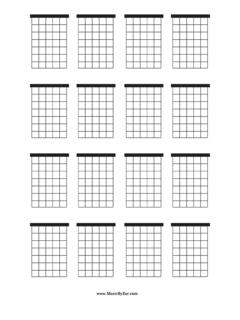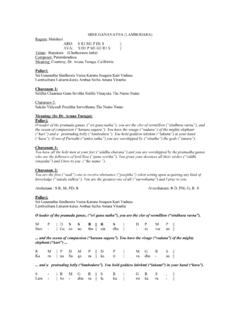Transcription of Style in Music - Carnegie Mellon School of Computer Science
1 Preprint from The Structure of Style : Algorithmic Approaches to Understanding Manner and Meaning, Shlomo Argamon, Kevin Burns, and Shlomo Dubnov (Eds.), Berlin: Springer-Verlag, 2010, pp. 45-58. Style in Music Roger B. Dannenberg Because Music is not objectively descriptive or representational, the subjective qualities of Music seem to be most important. Style is one of the most salient qualities of Music , and in fact most descriptions of Music refer to some aspect of musical Style . Style in Music can refer to historical periods, composers, performers, sonic texture, emotion, and genre. In recent years, many aspects of Music Style have been studied from the standpoint of automation: How can musical Style be recognized and synthesized?
2 An introduction to musical Style describes ways in which Style is characterized by composers and Music theorists. Examples are then given where musical Style is the focal point for Computer models of Music analysis and Music generation. Carnegie Mellon University 5000 Forbes Avenue Pittsburgh PA 15213 USA. ~rbd/. Computers are important in many aspects of Music composition, production, distribution, and analysis. In contrast to domains such as natural language, speech, and even images, Music rarely has a well-defined meaning, referent, or objective. Consider the sentence, Tie your shoes. There is a basic, objective meaning that forms a well-understood command (at least to English-speaking humans).
3 With spoken text and in different contexts, one can imagine all sorts of nuanced versions expressing anger, sympathy, embarrassment, impatience, authority, gentleness, and so on. Now consider a short melody without words. There is no obvious objective meaning, story, or referent associated with a pure melody. Everything that we enjoy (or not) about the melody has to do with expectations, sound quality, performance nuance, and musical texture. Essentially every aspect of the melody that communicates something to the listener is an aspect of Style . In that sense, Style is everything in Music . So Music is a wonderful domain to think about Style , but at the same time, Style is so broad and vague that we will only make progress if we deconstruct Style into more specific concepts.
4 As one might hope, Music theory and the many dimensions of Music orchestration and performance offer many opportunities to investigate Style . In addition to theoretical writings, there are many stylistic concepts that have been modeled with computers and studied more objectively. In the next section, we will discuss the nature of Style in Music and talk about how one might describe or characterize musical Style . This section is written for the musical novice. If you don't know anything about Music but you know what you like, perhaps this section will offer some terminology and help to understand how musicians think about Music structure and organization as it relates to Style . Section 2 presents a number of Computer models of Style for both analysis and generation.
5 This section will assume some general knowledge of Computer Science including data structures, and algorithms. What Is Musical Style ? In general, Style means a distinctive quality, form, or type. A more specific definition that certainly applies to Music is a particular manner or technique by which something is done, created, or performed. (Merriam-Webster 2007) In Music , the term Style is used in many ways: Historical periods of Music are associated with styles. For example, we might say a composition by Mozart is in the Classical Style , and one by Bach is in the Baroque Style . These styles can be more or less specific: in the recording industry, the term Classical is so broad that Mozart and Bach are both Classical composers, but a Music scholar might speak of late Classical or Neapolitan Baroque.
6 Styles are associated with composers. We can speak of composing in the Style of Beethoven. In this sense, Style means a set of characteristics generally found in the works of a particular composer.. Performers, especially improvising performers, also have styles. The ballad Style of Miles Davis refers to characteristics of Miles Davis's performances of ballads. Of course, great classical Music players interpret Music they perform even if the Music is not improvised. One can speak of the expressive Style of Itzhak Perlman, for example. Style can refer to aspects of musical texture. Texture is one of those words like Style . that is very difficult to pin down, and dictionaries do not consider the depth of meaning that texture has for composers.
7 Basically, musical texture is a composite of many aspects of Music that one would hear within a second or so. On longer time scales, melodic, rhythmic, and harmonic progressions stand out, but at shorter time scales, we hear timbre (violins?, electric guitars?, saxophones?), very short repeated patterns, many or few different pitches, loudness, and brightness, all of which give a subjective impression we call texture. While composers usually consider texture to be something different from Style , texture is at least a closely related concept. Texture usually refers to sound and the activity of making sound, while Style is most often used to describe the general impression or intention provided by a texture.
8 We speak of a tonal Style , a heavy Style , or a big band Style , all of which refer to texture-induced impressions. In these examples, the Style is not so much the melody, rhythm, or harmony, but the sound color in which these elements are embedded. Music is often described in emotional terms: exciting, soothing, calm, scary, etc. Sometimes Music causes listeners to experience emotions, and other times the listener may recognize an emotion without necessarily experiencing it. Either way, emotional associations are yet another way to describe the Style of Music . Style is often used to mean genre, yet another difficult-to-define term. A genre is a category of Music characterized by a particular Style , but a genre can also be influenced by social conventions, marketing, association with a particular artist, and other external influences.
9 Still, it is common to refer to something as rock Style , or bebop Style .. All of these definitions are related to the underlying idea that there are important characteristics of Music that we perceive as common or related across certain collections the work of a composer, the output of some historical period, or Music of some genre. Musicians study the elements of Music in detail and are familiar with ways in which these elements can be varied, giving rise to different styles. It is interesting that non-musicians can also perceive styles with great sensitivity, often with no ability to describe characteristics or differences. For these listeners, I will offer some terminology and discussion through examples.
10 Do not expect to become a musical expert, and do not believe that experts have a complete formal model of Style , but hopefully this discussion will explain some of the ways musical Style can be treated objectively. For more details on Music terminology, concepts, and history, the New Grove Dictionary of Music and Musicians (Sadie and Tyrrell, 2001) is an excellent reference. An Example: Baroque vs. Classical Style A good way to learn about musical Style is to examine the differences between two well-known styles. In this section, we will compare Baroque and Classical styles. The Baroque period extends from about 1600 to 1750 and includes Music by Monteverdi, Bach, Handel, and Vivaldi. As noted above, classical is sometimes used to refer to a broad range of styles sometimes referred to as Western art Music , which includes Renaissance, Baroque, Classical, Romantic, and many modern styles.



